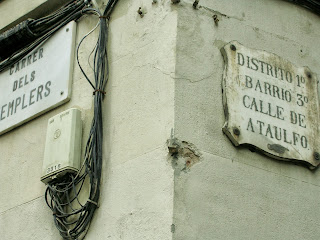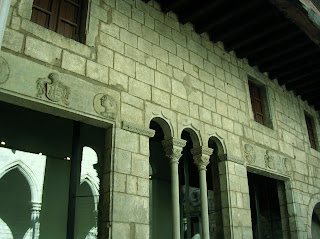Chapel of Palau Reial Menor, Maltese Cross Alisee Pattee, Exterior
Royal Palace Minor
Santa Maria de Palau
Royal Palace Minor
Santa Maria de Palau
Find tiny Atulf Street, Ataulf Street, in Barcelona, and there at #4 is the Chapel of Palau Reial Menor, Chapel of the Royal Palace Minor, with its multiple Alisee Pattee crosses. The Alisee Pattee crosses appear stenciled on the walls, or whatever other technique produces fine uniformity and exactitude. Here is one: what is that cross? Why is it here? In a little chapel that had been associated with one of the palaces of the nobility.
It is easily passed, with a nondescript facade. Its history of renovations make it difficult to figure original from change. This little chapel once was the Chapel of the Convent of the Knights Templar.
Knights Templar exoneration. Templars were accused of heresy, see Pope Clement V at http://www.papalencyclicals.net/Councils/ecum15.htm; and although it appears that Clement later exonerated them, he suppressed the order and it is only recently come to light. The history of the process, and the real motives of church and state involved, are worth a read, see http://catholicunderthehood.com/2010/05/02/today-in-catholic-history-pope-clement-v-and-the-knights-templar/ At a secret trial in Chinon, France, the Templars were exonerated, surprise. See http://www.catholicnewsagency.com/news/deatils_emerge_on_knights_templar_document_from_secret_archives/
In the 16th Century, the family Requesens renovated-rebuilt. The facade was also restored.. Today, the restored façade, the church is a No. 4 Street ATAULF with interesting art shows of the time, like a marble image of Our Lady of Victory Renaissance work of sculptor Martin Ten of Liatzasolo .
 Chapel of Palau Reial Menor, Barcelona. Facade, #4, Atulf Street, Ataulf Street. Chapel of the Royal Palace Minor.
Chapel of Palau Reial Menor, Barcelona. Facade, #4, Atulf Street, Ataulf Street. Chapel of the Royal Palace Minor.What is the significance of the M pattern on the doors? The place where Ataulf Street is found itself is a rabbit-warren of little streets, so narrow, twisting.
 Barcelona, Atulf Street, Ataulf Street, corner of Street of the Templars
Barcelona, Atulf Street, Ataulf Street, corner of Street of the Templars Back to the Alisee Pattee cross inside: Is it Templar? reasonably original, meaning what in terms of date. Or is it a later memorial of sorts to past uses.
And the Templars retain their old street in Barcelona.
 Barcelona, Street of the Templars, Carrers dels Templers
Barcelona, Street of the Templars, Carrers dels Templers It is not surprising that there is no Templar cross no version of a Maltese cross, on the exterior, as I recall. There is the double MM on the front doors.
...............................................................
Fn 1
1. Description. The distinctive equal-armed cross formation known as the Maltese Cross, comes in variations. One, as here, displays the wide ends fitting a circle, and equal arms (no crucifix idea), and is associated frequently with Templars. This rounded version is an early form used by early Hospitalers, or the Order of St. John in Jerusalem, which Order offered refuge to many Templars upon their persecution in 1312. See http://www.orderstjohn.org/osj/otherord.htm/. It is called the Cross Alisee Pattee, or the French croix pattée alésée arrondie.
Variations of Maltese Crosses later morphed into arms that were each representative of two spears, with eight pointed ends creating a circle, and much later than the Crusades: in the 1500's. See http://www.orderstjohn.org/osj/cross.htm.
2. Uses of the cross shape. Jerusalem itself reverted to the Muslims in 1187, and the Crusades ended in defeat. With those wars over, the formerly crusading Orders needed new employment and reinvented themselves for purposes that suited Pope and King in other directions, and fill their own and their sponsors' coffers.
Templars, however, as an early crusading order, may or may not have held at the time a monopoly on the Alisee Pattee cross. Each appearance today does not necessarily mean a Templar origin or meaning, probably.
3. The Alisee Pattee in particular. This shape would have been useful to Templars because it remained associated also with the Brothers of St. John. That enabled beleagured Templars under attack by minions of Pope and King could bear that cross shape with ambiguity and deniability about Templar significance. Would that ruse save lives, as the Templars themselves were persecuted nearly out of existence by the militant Christian church under that Pope Clement V, and efforts augmented by King Philip le Bel of France.
From the Templar founding in 1129, to its near destruction in 1312, implemented by said Pope and King, the Templars had become wealthy. Combining church and state to get and split the wealth of these mysterious monk-banker-crusaders served both Pope and King, both of whom wanted money. The wealth had accumulated during the crusades and after. The Roman Church had separated from the Eastern Orthodox in The Great Schism in 1054, and the new militant Roman branch, now autonomous, needed property, territory, prestige. So did the King. Let's have a war.
That is now largely forgotten. After the crusade against the Templars themselves, however, the issue remains. Who got the goods? People deposited their wealth and deeds with Templars for years during the Crusades, like bills of lading, and if the owner did not return, the property reverted to the Order. See FN 1, on Maltese-type crosses, research ongoing.
Dilution of the Maltese Cross. that history has been forgotten. The Maltese Cross idea had its origins in crusading invasions, religious slaughter of others for one's own cause as ordered by an unchallenged authority, Pope and King, and identification of one's own who then deserve protection, but no-one else. Is that so?
- Dilution of significance. The Maltese Cross now is seen, at least in the New York Fire Department, NYFD, as only a symbol of courage, the bearer being willing to lay down his or her own life to save any others. See http://www.nyc.gov/html/fdny//html/history/maltese_cross.shtml
- the Greek Cross,
- the Cross Formee (Wikipedia says this is also the Alisee Pattee, do a search, but a cross formee is not, I think, convex at the ends, rounded)
- the Formee Branchee,
- the Cross Pattee,
- the Formee Pattee,
- the Cross Fourchee,
- the Cross Millrine,
- the Cross Moline,
- the Cross Ancree,
- the Cross Cercelee,
- the Cross Potent,
- the Cross Formee Demi Sarcelled,
- the Alisee Pattee (focus here)
- the Cross Branchee or the Cross Fichee,
- the Cross Formee variant, the Patriarchal Cross,
- the Cross Double Fitched.
See pictures of these variations on the Maltese Cross at http://www.orderstjohn.org/osj/cross.htm
The modern Maltese cross, with its eight points, was introduced in the 1500's. Put that one away in your mind in looking at early crosses. That radical change was implemented a long time after Jerusalem reverted to the Muslims, and the Crusades formally ended in defeat, in 1187.
The modern Maltese cross, with its eight points, was introduced in the 1500's. Put that one away in your mind in looking at early crosses. That radical change was implemented a long time after Jerusalem reverted to the Muslims, and the Crusades formally ended in defeat, in 1187.
 Pablo Picasso, Museu Picasso, Barcelona
Pablo Picasso, Museu Picasso, Barcelona Pablo Picasso Museum, Barcelona. Contrasts in design, relationship to light, eras.
Pablo Picasso Museum, Barcelona. Contrasts in design, relationship to light, eras. Picasso Museum, Barcelona. Moorish evolved into Renaissance in parts.
Picasso Museum, Barcelona. Moorish evolved into Renaissance in parts.  Dedication, Pablo Picasso, at Museum, Barcelona
Dedication, Pablo Picasso, at Museum, Barcelona Pablo Picasso Museum, Barcelona. Outdoor stairway connecting levels of the palaces comprising the mussr
Pablo Picasso Museum, Barcelona. Outdoor stairway connecting levels of the palaces comprising the mussr Galleon, Barcelona. Pinta-Nina-Santa Maria type. Christopher Columbus. .v
Galleon, Barcelona. Pinta-Nina-Santa Maria type. Christopher Columbus. .v Barcelona harbor, Christopher Columbus.
Barcelona harbor, Christopher Columbus. Christopher Columbus: From whom came his education.
Christopher Columbus: From whom came his education. Colom, Columbus, Colon. Original name, to later spellings, Christopher Columbus.
Colom, Columbus, Colon. Original name, to later spellings, Christopher Columbus. Columbus, life of, Barcelona harbor.
Columbus, life of, Barcelona harbor. Columbus did no wrong. Barcelona harbor. Vet.
Columbus did no wrong. Barcelona harbor. Vet. Columbus, seeking financing? Barcelona harbor.
Columbus, seeking financing? Barcelona harbor. Queen Isabella made Columbus' first dreams come true. Barcelona harbor.
Queen Isabella made Columbus' first dreams come true. Barcelona harbor.